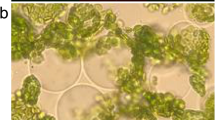Summary
For the purpose of patch-clamp studies, a protoplast isolation procedure is presented in which an osmotic shock (changing the osmolarity of the medium) and centrifugation step are omitted to limit mechanical stress. Apart from the reduction of mechanical stress factors, protoplast washing is also limited. Protoplasts have been isolated from different monocotyledonous and dicotyledonous plant species and from different tissues (leaves and roots). The seal success rate in patch-clamp experiments was high (about 85% successful seals showing a seal resistance > 10GΩ). To evaluate the electrogenic viability of the protoplasts, fusicoccin and light responses of the plasma membrane and channel activity were tested. The addition of fusicoccin to the bathing medium caused typical high activation of the proton pump. Switching the light on and off caused transient depolarizations and hyperpolarizations, respectively, matching data reported for mesophyll cells in micro-electrode studies. Whole-cell and single-channel recordings of protoplast plasma membranes isolated from intact tobacco andArabidopsis leaves were comparable with data published for protoplasts from corresponding tissue cultures. It is concluded that our isolation procedure yields protoplasts with electrogenic responses and is therefore suitable for patch-clamp studies in physiological research.
Similar content being viewed by others
Abbreviations
- K4BAPTA:
-
potassium-1,2-bis(2-aminophenoxy)-ethane-N,N,N′,N′-tetraacetic acid
- BTP:
-
1,3-bis[tris(hydroxy-methyl)-methylamino]propane
- Hepes:
-
4-(2-hydroxyethyl)-1-piperazineethane sulphonic acid
- Mes:
-
2-(N morpholino)ethane sulphonic acid
- Tris tris:
-
(hydroxymethyl)aminomethane
- WC:
-
whole cell
References
Bhojwani SS, Razdan MK (1983) Protoplast isolation and culture. In: Bhojwani SS, Razdan MK (ed) Plant tissue culture: theory and practice. Elsevier, Amsterdam, pp 237–260
Colombo R, Cerana R (1991) Inward rectifying K+-channels in the plasma membrane ofArabidopsis thaliana L. Plant Physiol 97: 1130–1135
De Ruiter H, Uffing AJM, Meinen E, Prins A (1990) Influence of surfactants and plant species on leaf retention of spray solutions. Weed Sci 38: 567–572
Elzenga JTM, Keller CP, Van Volkenburgh E (1991) Patch clamping protoplasts from vascular plants. Method for quick isolation of protoplasts having a high success rate of gigaseal formation. Plant Physiol 97: 1573–1575
Galun E (1981) Plant protoplasts as physiological tools. Annu Rev Plant Physiol 32: 237–266
Hansen U-P, Moldaenke C, Tabrizi H, Ramm D (1993) The effect of transthylakoid proton uptake on cytosolic pH and the imbalance of ATP and NADH/H+ production as measured by CO2- and light-induced depolarisation of the plasmalemma. Plant Cell Physiol 34: 681–695
Jordi W, Dekhuijzen HM, Stoopen GM, Overbeek JHM (1993) Role of other plant organs in gibberellic acid-induced delay of leaf senescence inAlstroemeria cut flowers. Physiol Plant 87: 426–432
Koorneef M, Hanhart CJ, van der Veen JH (1991) A genetic and physiological analysis of late flowering mutants inArabidopsis thaliana L. Mol Gen Genet 229: 57–66
Larkin PJ (1976) Purification and viability determinations of plant protoplasts. Planta 128: 213–216
Marré E (1979) Fusicoccin: a tool in plant physiology. Annu Rev Plant Physiol 30: 273–288
— (1985) Fusicoccin- and hormone-induced changes of H+ extrusion: physiological implications. In: St. John J, Berlin E, Jackson P (eds) Frontiers of membrane research in agriculture. Rowman and Allanheld, Ottawa, pp 439–460
Moran N, Ehrenstein G, Iwasa K, Bare C, Mischke C (1984) Ion channels in plasmalemma of wheat protoplast. Science 126: 835–838
Ogden DC, Stanfield PR (1988) Introduction to single channel recording. In: Standen NB, Gray PTA, Whitaker MJ (eds) Microelectrode techniques, the Plymouth workshop handbook. The Company of Biologists, Cambridge, pp 63–82
Qian YC, Nguyen T, Murphy TM (1993) Effect of washing on the plasma membrane and on stress reactions of cultured rose cells. Plant Cell Tissue Organ Culture 35: 245–252
Schroeder JI, Hedrich R, Fernandez JM (1984) Potassium selective single channels in guard cell protoplasts ofVicia faba L. Nature 312: 361–362
Spalding EP, Cosgrove DJ (1988) Large plasma-membrane depolarization precedes rapid blue-light-induced growth inhibition in cucumber. Planta 178: 407–410
Steiner AA (1968) Soiless culture. In: Proceedings of the 6th Colloquium of the International Potash Institute, Florence, Italy. International Potash Institute, Bern, pp 324–341
Van Duijn B (1993) Hodgkin-Huxley analysis of whole-cell outward rectifying K+-currents in protoplasts fromTobacco cell suspension cultures. J Membr Biol 132: 77–85
Vogelzang SA, Prins HBA (1992) Plasmalemma patch-clamp experiments in plant root cells: procedure for fast isolation of protoplasts with minimal exposure to cell wall degrading enzymes. Protoplasma 171: 104–109
— — (1994) Patch-clamp analysis of the dominant plasma membrane K+-channel in root cell protoplasts ofPlantago media L. Its significance for the P- and K-state. J Membr Biol 141: 113–122
Author information
Authors and Affiliations
Rights and permissions
About this article
Cite this article
Blom-Zandstra, M., Koot, H.T.M., van Hattum, J. et al. Isolation of protoplasts for patch-clamp experiments: an improved method requiring minimal amounts of adult leaf or root tissue from monocotyledonous or dicotyledonous plants. Protoplasma 185, 1–6 (1995). https://doi.org/10.1007/BF01272748
Received:
Accepted:
Issue Date:
DOI: https://doi.org/10.1007/BF01272748



